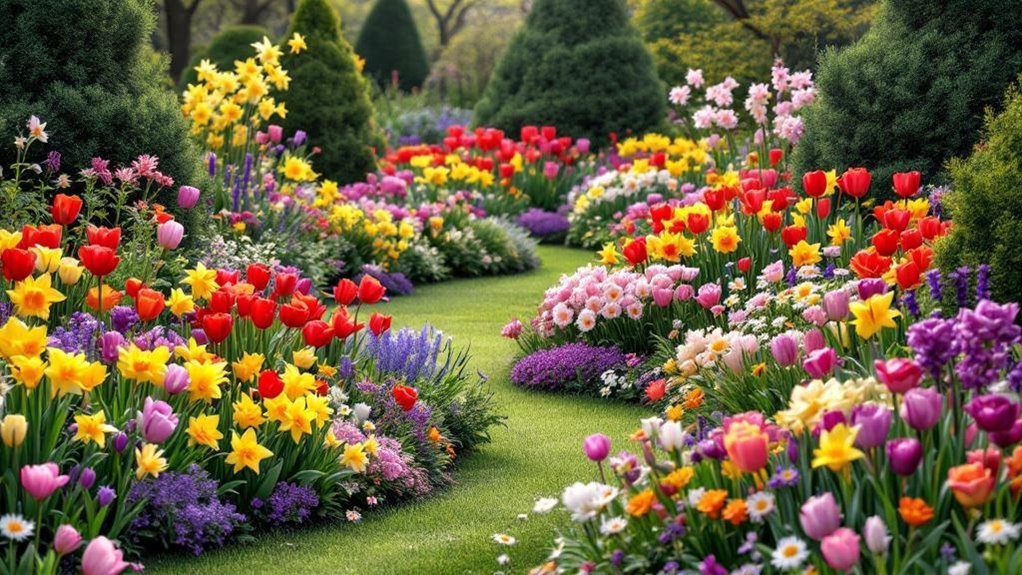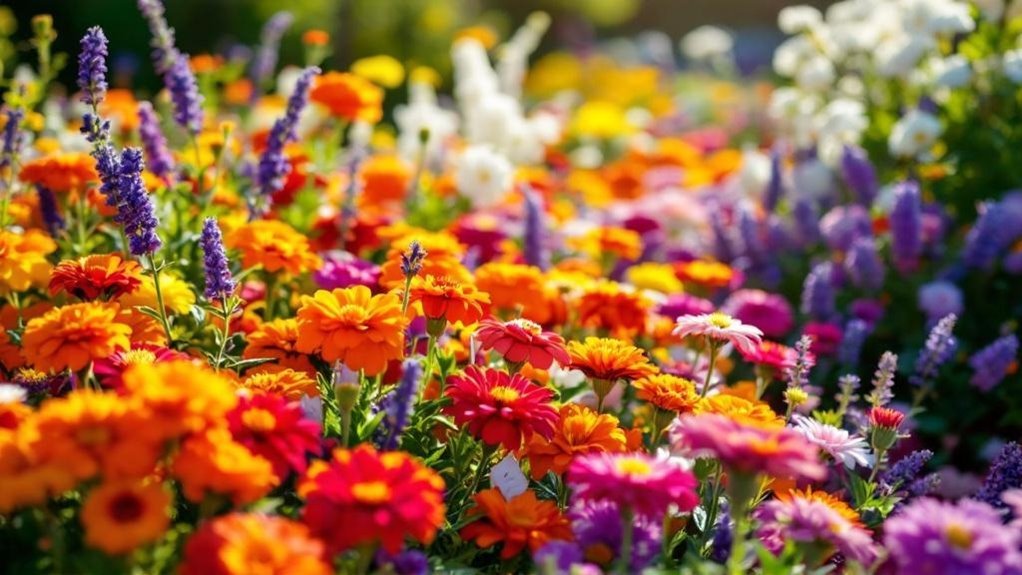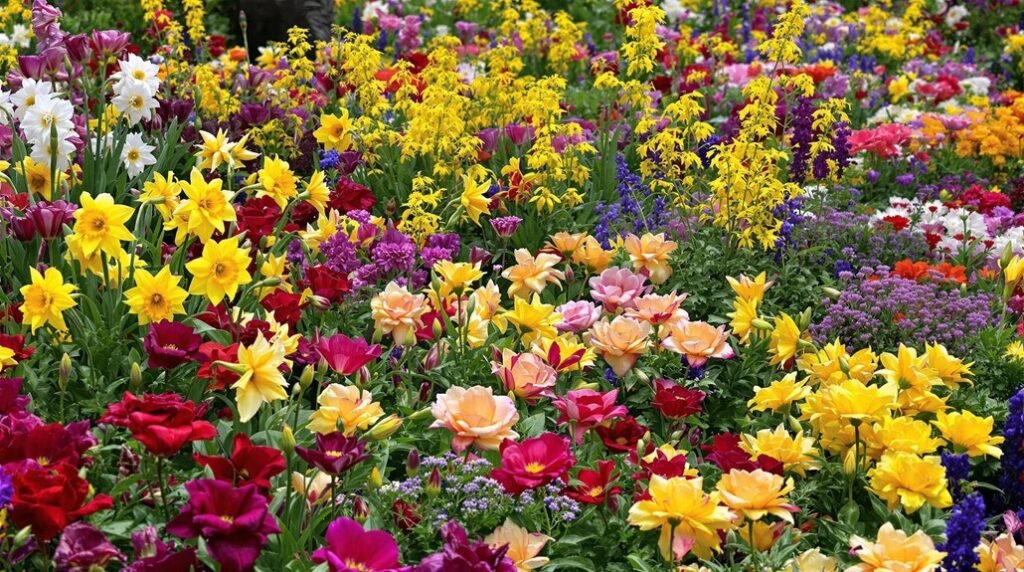You might be surprised how much planning goes into keeping your flower garden vibrant all season long. By timing your plantings carefully and choosing the right mix of flowers, you can avoid those dull gaps when nothing seems to bloom. But it’s not just about picking pretty plants—it’s about understanding your climate, frost dates, and how different species interact. Once you get this rhythm down, your garden will reward you with continuous color that evolves throughout the year.
Planning Your Succession Planting Calendar
When you plan your succession planting calendar, start by pinpointing your last spring and first fall frost dates, as these crucial markers set the framework for your entire schedule.
Knowing your last spring frost date helps you decide when to begin sowing seeds outdoors or indoors for early spring blooms. Similarly, the average first fall frost guides your final sowing date, ensuring plants mature before cold weather arrives.
Check each flower variety’s days to bloom to time your plantings for continuous supply throughout the growing season.
Divide your garden area into sections and stagger sowings from early to late spring.
Keep a detailed planting schedule to optimize succession planting, giving you blooms well beyond a single season and a vibrant garden from the first warmth to the last chill.
Selecting Annuals and Perennials for Extended Bloom
To keep your garden blooming continuously, you’ll want to select a mix of annuals and perennials that flower at different times throughout the season.
Choosing annuals like Zinnias and Cosmos lets you enjoy staggered blooms, providing vibrant color from spring through fall.
Annuals such as Zinnias and Cosmos ensure vibrant, staggered blooms all season long.
Perennials such as Echinacea and Rudbeckia offer reliable, extended bloom periods, forming a strong garden backbone.
By carefully planning your succession planting, you can combine early- and late-blooming varieties to guarantee continuous flowers and minimize color gaps.
Companion planting annuals and perennials also helps conceal fading foliage while introducing fresh blooms, maintaining visual appeal.
Understanding each plant’s bloom time and growth habit is key to your selection, enabling a seamless flow of color and continuous flowering throughout the gardening season.
Incorporating Bulbs and Shrubs for Seasonal Interest

Although bulbs and shrubs might seem like separate elements, combining them can bring vibrant, seasonal interest to your garden.
By layering these plants thoughtfully, you guarantee continuous color throughout multiple flowering seasons. Start with spring-blooming bulbs like daffodils and tulips, then add perennials to mask fading foliage.
Incorporate summer-blooming bulbs such as lilies and dahlias to extend color into warmer months. Flowering shrubs like hydrangeas and butterfly bushes add structure and multi-season appeal with blooms and berries.
- Plant spring bulbs early for a bright season start
- Layer perennials to cover bulb dieback
- Add summer-blooming bulbs for extended color
- Choose flowering shrubs for year-round visual appeal
- Combine bulbs and shrubs strategically for seamless seasonal interest
This planting approach maximizes your garden’s continuous color and biodiversity.
Using Evergreens and Foliage to Enhance Color Continuity
Since flowering plants often have limited seasons, incorporating evergreens and foliage into your garden guarantees it stays vibrant year-round.
Evergreens provide a sturdy backdrop that maintains color continuity when seasonal flowering plants stop bursting with blooms. You can use various shades of evergreens to add visual interest through winter, especially by concealing the unsightly foliage of dormant bulbs.
Foliage plants, including colorful shrubs, add multi-seasonal interest with their changing leaf colors and occasional fruit, complementing your flowers beautifully.
Beyond aesthetics, evergreens serve as natural windbreaks and create a wildlife habitat, supporting a healthy garden ecosystem.
Tips for Maintaining and Adjusting Your Succession Garden

Blending evergreens and foliage into your flower garden sets a strong foundation for year-round interest, but keeping your succession planting thriving requires ongoing attention.
To maintain continuous color and maximize success, you’ll need to monitor your garden closely and adjust planting schedules as conditions change. Here are key tips for maintaining and adjusting your succession garden:
Maintaining vibrant blooms requires close monitoring and flexible planting schedules tailored to changing garden conditions.
- Track planting dates and crop varieties for efficient succession planting management.
- Regularly monitor your garden by taking notes and photos to assess plant health and bloom timing.
- Adjust planting schedules based on weather, especially when sowing seeds or planting for your flower in early summer.
- Replace faded or underperforming plants with fast-growing varieties to sustain vibrant interest.
- Use companion planting to improve soil health and pest control, enhancing cut flower quality and overall plant vigor.
Frequently Asked Questions
What Flowers Are Good for Succession Planting?
You should try Zinnias and Sweet Peas since you can sow them every few weeks for steady blooms. Also, plant Amaranthus and Bachelor’s Button in intervals, and add Sunflowers for variety and continuous color.
How to Arrange Flower Colors in a Garden?
You should group flowers by color families, like warm or cool tones, and mix complementary colors using the color wheel. This way, you’ll create visually striking arrangements that feel balanced and attract pollinators to your garden.
How to Plant a Colorful Flower Garden?
You’ll choose diverse flowers blooming at different times, plant them in intervals, and mix heights and colors. Don’t forget companion plants to boost growth and keep your garden vibrant all season long.
What Color Flowers to Plant Together?
Think of your garden as a vibrant storybook—pair warm reds and yellows with cool blues and purples to balance excitement and calm. You’ll create harmony by mixing analogous colors or bold contrast with complementary ones.
Final Thoughts
Think of your flower garden as a well-composed symphony, where each bloom plays its part in perfect harmony. By planning your succession planting carefully, you’re the conductor guiding nature’s orchestra to create continuous color that never misses a beat. Just like a melody that lingers in the air, your garden’s vibrant display will flow seamlessly from spring to fall, reminding you that with thoughtful care, beauty can unfold endlessly, season after season.
